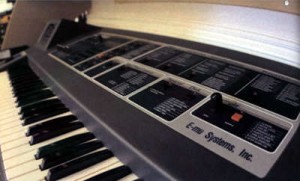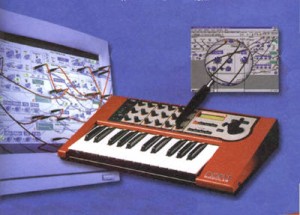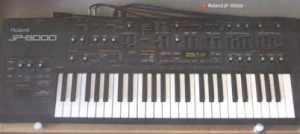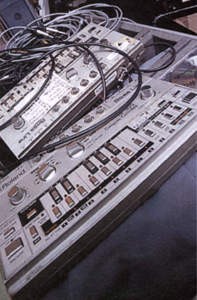Alexey Borisov Down “Night Avenue” of first Russian electronic music People and Instruments. From “BESM-6” to … 2004.
 |
| Emulator- 2 |
In the beginning of the 70’s I moved to Cheryomushkinsky district of Moscow. My parents were given a separate apartment (before that we lived in a communal apartment near Mir Avenue) in a so-called house of improved conditions or just DAS (House of post-graduate and intern students in Svernik Street), which belonged to Moscow State Lomonosov’s University. Views of this construction can be seen in final scenes of E. Ryazanov’s comedy “Irony of Fate”. This then ultramodern house was mainly inhabited by students and post-graduates, and only several floors in the second building was occupied by families of MSU employees, who became participants of a sociological experiment on establishment of a new household. Certainly, the experiment flopped, but we got a beat-group, formed by a post-graduate from Azerbaijan. From this very band, where I started playing the bass guitar when I was in the 7th form, my music career began. I started listening to contemporary music more seriously, attempting to break it down into styles and trends, to single out and distinguish sounds of separate instruments. In the 70’s or maybe earlier, in Russia there was a notion of electronic music, which I associated mainly with cartoons, documentary and sci-fi movies, as well as with the orchestra of electronic musical instruments guided by Vyacheslav Meshcherin, which played on TV and radio mostly waltzes, easy-listening classical and pop music. The orchestra used electric organs, accordions, harps, violins and other instruments of traditional appearance, but equipped with pick-ups. At that moment it seemed uninteresting, boring and unattractive to me. Playing and sound of electronic instruments of the Meshcherin’s orchestra seemed too cold and lacking of energy, which distinguished rock music from other styles. On the other hand, in our band we used Soviet organ “Yunost”, which could produce quite weird sounds, if treated in a special way. Of course, it couldn’t compare with Hammond organ or all other numerous keyboards, which could be seen of the sleeves or heard on the discs of such bands as Deep Purple, Pink Floyd, ELP, Yes, Genesis or at concerts of Soviet ensembles, which were well equipped with imported instruments and appliances. In the second half of the 70’s, such names as Klaus Schultze, Tangerine Dream and even Krafwerk emerged among my friends. However, information about them was minimal, and the only electronic instrument we had was “Yunost” organ, connected to a self-made distortion or a domestically manufactured wah-wah.
Meanwhile, my father worked in a computation center of the Moscow University and from time to time arranged excursions to the center for me and my classmates. In was in mid 70’s. A huge domestically made computer (BESM-6) occupied a large pavilion, working 24 hours a day. Visually it reminded of a space station or the control room of a nuclear reactor, where various devices produced regular buzz and were illuminated by multicolor lights. The facility was for authorized personnel only, and technicians wore special gowns, performing odd manipulations with magnetic bands and numerous punched cards, which stored a considerable for those days amount of information. Several times my father showed me pictures, made by the machine, as well as made it speak and play some primitive and poor quality music. However, it impressed me for the whole life.
At some moment (around 1978), at my birthday my friends presented me with Oxygen by Jean Michel Jarre, some electronic disco and fusion music, and it became obvious that in those living and technical conditions it was impossible to make electronic music. Only in the beginning of the 80’s the situation improved a little. With emergence of punk and new wave electronic music became more comprehensive and accessible, including a technical aspect. My colleagues from Center group, where I played the guitar in 1980-1981, started experimenting with electronic instruments, provided by Mikhail Mikhaylyuk, a professional musician (member of studio electronic project “Valery Chkalov’s Squad”) and simultaneously an unofficial vendor of musical instruments. It was the first time I came across a Roland rhythm box, bass line (it was the legendary Roland TB-303) and Casio instruments. I was particularly impressed by Korg MS-20, an excellent analog synthesizer, which seemed to open the doors to the world of real electronic music. By the way, many of these instruments were adopted by Night Avenue (Nochnoy Prospekt), founded by me and keyboard player Ivan Sokolovsky in 1985. Before that (1981-1984) within a student beat group Prospekt we attempted to combine the sound of electronic instruments with guitars, using self-made electronic drums and “Yunost” with other mini-organ, FAEMI, which in combination with a fuzz box produced an impression of a very aggressive noise instrument. Under the influence of XTC, The Stranglers, Ultravox, Cabaret Voltaire and Joy Division, we intuitively tried to mix energy of punk rock with a colder, but in the same time more aesthetic and futuristic electronic sound. Of course, we were not alone in this endeavor, but in Russia there was a long-lasting conviction that electronic music of the end of the 70’s – beginning of the 80’s was a disco variation, an exclusively commercial phenomenon, unacceptable from the point of view of true rock music.
 |
| Nord-modular |
However, since 1985, ignoring the pressure of the administration of Rock Laboratory (a semi-professional organization, initiated in 1985 by Mnistry of Culture, KGB and Komsomol in order to unite and control numerous underground rock groups), membership in which allowed us to perform legally, Sokolovsky and me abandoned traditional rock instruments (except for guitar) and started using exclusively drum machines, keyboards and synthesizers as a duo, sometimes engaging our friends percussionists Sergey Pavlov and Alexey Raskatov (both ex-Prospekt) and female singer Natasha Borzhomova.
Our electronic arsenal was certainly far from perfection. We sued several variants of Soviet electronic organ FAEMI, different mini-Casio’s, small Bontempi keyboards, which were brought by Ivan’s mother from abroad. From time to time we added synthesizers Korg Poly-800, Korg MS-20, Roland Juno-106, Roland TB-303, Korg and Boss drum machines, which we borrowed from our colleagues. Sometimes we used Vermona instruments (made in GDR), where were very popular in the USSR. Later we used Yamaha RX-11 drum machine and Yamaha DX-7, DX-21 and DX-100 synthesizers. Soviet industry launched various keyboards on the market, including the best known Elektronika instruments, electric organs Lel’, as well as Polyvox synthesizer, resembling the legendary MiniMoog. However, these instruments, in spite of low prices, seemed to us too cumbersome, unreliable in operation, unpredictable in controlling and very rough-sounding. Only in the 90’s we could worthily appraise all highs and lows of these instruments. They were particularly demanded for creation of industrial and experimental music, becoming highly collectible rarities.
Those days (1984-1987) we recorded blank pieces on tape, using a UHER reel recorder and, later, a modified NOTA recorder, to which we performed on stage, playing live the guitar and portable Casio’s. This practice of the mid 80’s later was adopted by various pop groups, who further applied complete lipsing instead of playing live.
In the second half of the 80’s a so-called “electronic scene” was established in Moscow. It mainly inclined to pop forms, but also revealed some innovations and searching for independent ways of playing and composing electronic music. Of course, the main reference for most Russian musicians was Depeche Mode, whose popularity in Russia was immense. Among representatives of Moscow electronic scene of the 80’s I need to mention such bands as BIOCONSTRUCTOR, ALLIANCE, Vladimir Ratskevich’s VECTOR, DOCTOR, Alexey Tegin’s SECOND GROUP, GOODBYE TO YOUTH duo, Alexander Sinitsin’s UNION OF COMPOSERS, Yuri’s Tsaryov’s METRO, as well as electronic side-projects Yuri Orlov (NICOLAS COPERNICUS) and Vasily Shumov (CENTER). In Leningrad the electronic sound was adopted by AVIA, TELEVIZOR and MODEL, as well as the studio duo NEW COMPOSERS and the legendary avant-gardist Sergey Kuryokhin. There was a kind of a scene in Baltic republics, but local electronic musicians, except for ZODIAC, as a rule, were hardly known outside Latvia, Lithuania and Estonia.
It needs to mention, that in the 80’s Russian electronic bands faced a lot of problems, especially at concerts. First of all, acoustic systems of those days were of poor quality and mainly designed for rock instruments. On the other hand, the audience was very skeptical about electronic music and just couldn’t apprehend experimental forms of musicianship. That is why performances of electronic musicians in the 80’s were held in extremely difficult and unfavorable conditions as compared with numerous rock-bands. Very exemplary in this respect was an audition of Laboratory’s groups in 1988 in order to attest and rate them. For the whole day in Gorbunov’s Cultural Center different experts (Malikov, Kozlov, Saulsky, etc.) and musicians assessed performances of their colleagues. All electronic bands (though there were only three of them) flapped, especially Night Avenue, which wasn’t attested at all (by the way, like favorites of Moscow audience ZVUKI MU) and received the minimum rating in the amount of five rubles (or something of the sort) per concert. Against the background of mobile rock-bands, electronic musicians with their synthesizers looked awkward and ambitiously. It took a long time for them to plug and tune and, in the result, they sounded unconvincingly and flabby.
As for Night Avenue, since 1987 we started gradually to enrich our instruments set, moving towards industrial-electronic psychedelia. In addition to sampling equipment and a powerful analog synthesizer Korg MonoPoly we started using an acoustic drumkit, on which Sergey Pavlov played, and electric violin of Dmitry Kutergin, who was a former leader of DOCTOR and played with DK, Eduard and Artyom Artemyevs and the global art project POP-MECHANICS of Sergey Kuryokhin. We also used a xylophone and extended the range of guitar effects. Ivan Sokolovsky, who was responsible for the electronic part, also used guitar gadgets, numerous self-made devices (for example, a vocoder), as well as synthesizers and drum machines of different generations and manufacturers. Our basic electronic kit of the late 80’s consisted of Roland TB-303, Korg MS-20, Korg MonoPoly, Korg Superpercussion and a childish Casio sampler. In the studio we still used various Yamahas, sometimes an excellent Oberheim drum machine and early variants of Akai samplers, which were owned by some Moscow musicians in the late 80’s. In our special performances, prepared for festivals and gallery happenings, we attempted to use a button accordion, various pick-ups and contact microphones, acoustic string instruments and small metal constructions in combination with effect processors and loops, recorded on magnetic tapes. In this period I particularly started to use Korg MS-20 as a guitar processor. In the end of the 80’s the major part of Sokolovsky’s collection of synthesizers was at my place, which allowed me to pay more serious attention to my solo works, to record various experiments on a 4-channel Tascam port studio and a regular Technics cassette recorder.
 |
| Roland -JP8000 |
In 1989 Sokolovsky quit Night Avenue, pursuing his solo career. For some period we had no electronic instruments and started playing as a traditional rock group, using guitar, bass, drums and electric violin. Our new member, bass player Alexey Solovyov, was a good keyboard player, who also owned Roland Microcomposer, a very promising analog instrument, which became popular in the 90’s. Later, he went into hip-hop and acid-house, which influenced records of Night Avenue in the beginning of the 90’s. He was one of the first in Russia to fuse folk and dance music, created a club garage project RAKETA and became a producer of first Russian collections of electronic music.
In the end of the 80’s the situation started changing not only in music, but also in technology. Very soon Moscow studios and some musicians started replacing analog synthesizers with digital ones. All kinds of workstations became fashionable. Owners of the studios paid more attention to sampling equipment. Such trends reflected in studio processes of Night Avenue, when during recording of some works we sampled instruments completely and then controlled the sampler (it was Roland S-10 and later Roland W-30, sometimes Emulator II and Ensoniq samplers) with the help of a digital sequensor. However, at a certain moment, digital equipment also seemed limited in terms of sound and it was quite expensive. As a result, instrument set of Night Avenue and the more experimental duo F.R.U.I.T.S., created in 1992 by composer and producer Pavel Zhagun, was increased by analog synthesizers, including Roland TB-303, Roland Microcomposer, Crumar Performer, MiniMoog and other instruments, which were highly rated in the 70’s and early 80’s. For some period they were out of fashion and hardly used by most of Russian musicians, especially those, who played traditional rock with keyboards addition or produced commercial pop-products. At that moment, we and some our colleagues (particularly, Roman Belavkin aka Solar X) started active use of all kinds of Soviet synthesizers, which, as turned out, had been produced in abundance (Polyvox, Ritm-2, Aelita, different Electronikas, Lel’ drum machine, various synthesizers produced in Baltic republics, etc.). All these devices had very specific sound, different from Japanese or European instruments. In the middle of the 90’s Moscow experienced a real boom of demand for analog synthesizers and old drum machines. At the same time, Moscow was flooded by latest equipment from abroad, and, besides instruments from well-known producers, some Moscow musicians obtained exotic and quite expensive instruments from Quasimidi, Waldorf, Clavia, Doepfer, etc. Relatively cheap groove-boxes, allowing to produce music operatively and, most important, with a good quality, came into fashion. Many musicians in the 90’s gathered impressive collections, where one could see instruments of different generations, companies and countries. The champions were Richards Norvilla (BENZO, E-SHAK and other projects), Yuri Orlov (NICOLAS COPERNICUS, F.I.O., COLD HAND OF MOSCOW), Nikolay Nebogatov (Spies Boys/NN Records), members of SOLARIS STATION project and some other representatives of Moscow electronic scene.
In the 90’s, my personal collection replenished with drum machines Roland TR-626, TR-707, Korg DDM-110, synthesizer Roland SH-101 and Russian devices – analog synthesizer RITM-2, LEL’ drum machine and trigger module. Moreover, I returned to active use of various guitar effects, especially distortions and fuzzes, mainly self-made. Availability of midi-instruments and older trigger devices gave me an opportunity to promptly commutate at different studios and effectively play experimental concerts and dance sets. In my opinion, so-called hardware, especially of old design, can be successfully combined with modern computer technologies, creating a unique sound and providing an illusion of live playing and feeling of improvisation .
The second half of the 90’s for me was in endless tours over Russia, both solo and in some small projects, where I had to play electronic music of a wide range in absolutely different places and environments. More over, availability of compact and mobile instruments in combination with DJ techniques helped in my visits to Europe, when I established interesting contacts and enhanced my performance abilities to play in any facility and to get promptly adjusted in any project.
Current situation in Russian electronic music is very similar with Europe or America. Total computerization of musical process is taking place, with is conditioned by natural development of technologies, as well as objective economic reasons. It is understood that computers provide endless possibilities to musicians. However, computer technologies are able to level or standardize the product to such an extent, that various aesthetic, national, emotional, personal and other subjective features of the producer could just disappear. For many people such a situation of “sound and technological cosmopolitism” is unacceptable, but for some, on the contrary, is very attractive and the only possible one. Meanwhile, Russia still remains a closed country, including its cultural sphere. Vast territories and considerable number of population stay in informational and technological isolation. Absence of a single music market also affects development of musical processes, including the field of electronic music. Of course, a certain role is played by specific Russian mentality, which still can’t be clearly apprehended and, most likely, is a combination of some very subjective social-psychological, linguistic and cultural peculiarities, conditioned by local age-long traditions, as well as peculiarities of the historical process within a given territory. Such nuances can influence not only local or regional situation, including musical sphere, but also different world-wide and global processes. This influence can be positive or negative. With an adverse development of the situation negative moments will prevail, finally helping global growth of absurdity, uncontrolled anarchy and, as a result, an inevitable collapse of the world civilization.
 |
| Roland TB-303 bass-line |
To a certain degree, Russian electronic music in general is a continuation or development of traditions of Russian avant-garde (neo-futurism, suprematism, constructivism, absurdism, etc.) in combination with mass worshiping of scientific and technical progress. Since 1920’s Russia (and later East Europe and a part of Asia) became a large training ground for testing and probation of various social-economic schemes, technological ideas and different inventions, as well as national economic experiments. At some moment, in Russia a specific idolization of machines, industrial architecture, electricity, science and the very labor process occurred. Moreover, industrialization of the society and scientific and technical progress in general obtain a political character, becoming a part of communist ideology and a means of fighting against western imperialism and capitalism. Russian electronic environment subconsciously reflects this phenomenon, being a kind of symbol of “sacralization” of the very act of music production with the help of sophisticated devices and latest computer programs.
As a result, a certain hypothetic task of Russian electronic music is to combine harmoniously and effectively its intellectual potential with the cult of technology. On the other hand, for local musicians it makes sense to overcome a certain technological dependence or even inferiority to achieve artistic freedom, mental liberation and independence from various cliches and notorious international standards. Just then, in my opinion, an interesting result is possible, with can absorb the entire variety and depth of Russian “cultural chaos”, providing at the same time a considerable influence on world-wide creative processes.
january 2004
Leave a Reply